 Misconceptions
Misconceptions  Misconceptions
Misconceptions  History
History 10 Amazing Roman Epitaphs
 Weird Stuff
Weird Stuff 10 Niche Subcultures That Are More Popular Than You Might Think
 Mysteries
Mysteries 10 Tragic Disappearances and Deaths in Joshua Tree National Park
 History
History 10 Ways Childhood Really Sucked in the Old West
 Music
Music 10 Name Origins of Famous Bands from the 1990s
 Religion
Religion 10 Biggest Turnarounds by the Catholic Church
 Weird Stuff
Weird Stuff 10 Unbelievable Times Laws Had Unintended Consequences
 Humans
Humans Ten Historic Women Who Deserve Way More Credit Than They Got
 Movies and TV
Movies and TV 10 Films That Spawned Major Lawsuits
 Misconceptions
Misconceptions 10 Phony Myths and Urban Legends That Just Won’t Die
 History
History 10 Amazing Roman Epitaphs
 Weird Stuff
Weird Stuff 10 Niche Subcultures That Are More Popular Than You Might Think
Who's Behind Listverse?

Jamie Frater
Head Editor
Jamie founded Listverse due to an insatiable desire to share fascinating, obscure, and bizarre facts. He has been a guest speaker on numerous national radio and television stations and is a five time published author.
More About Us Mysteries
Mysteries 10 Tragic Disappearances and Deaths in Joshua Tree National Park
 History
History 10 Ways Childhood Really Sucked in the Old West
 Music
Music 10 Name Origins of Famous Bands from the 1990s
 Religion
Religion 10 Biggest Turnarounds by the Catholic Church
 Weird Stuff
Weird Stuff 10 Unbelievable Times Laws Had Unintended Consequences
 Humans
Humans Ten Historic Women Who Deserve Way More Credit Than They Got
 Movies and TV
Movies and TV 10 Films That Spawned Major Lawsuits
10 Killer Creatures That Are Actually Helping Heal
In the animal kingdom, bright, dazzling colors usually mean danger—stay away! Some scientists, though, are willfully ignoring these clear signals for one important reason: Animal venoms and poisons have proven to be invaluable in the development of new medications for conditions like chronic pain, diabetes, and even cancer. This list takes a look at 10 deadly critters that science is using to help heal the masses.
10 Poison Dart Frog

Most of the animals on this list are venomous, meaning they transfer toxins to their predators or prey via injections, like bites or stings. However, poison dart frogs, as their name suggests, are actually poisonous, meaning that their typical mode of toxin delivery is through ingestion.
But these colorful frogs don’t actually make their poison themselves. In fact, they steal their poison from the “creepy-crawlies” they eat, like ants and centipedes. Once the frogs eat their fill, they secrete the repurposed toxins through their brightly colored skin, helping to ward away predators.
So how are these frogs helping with medical research?
One species in particular, Epipedrobates tricolor, has been useful in creating a non-opioid analgesic.[1] In layman’s terms, this means that the toxins produced by this particular species of frog have been studied, modified, and synthesized to make a nonaddictive painkiller named “epibatidine” after the frog.
But you probably will not be getting a prescription for two frogs every four hours from a doctor anytime soon. Epibatidine was still toxic to rats even at low, therapeutic doses, so the drug was discontinued.
Another family of frog, Dendrobatidae, has shown promise in research on appetite suppressants, muscle relaxants, and heart stimulants. So our froggy friends might still make an appearance in our medicine cabinets one day.
9 Sea Anemone

Almost all of us are somewhat familiar with sea anemones, if only because of Pixar’s Finding Nemo. In the movie, both clownfish, Marlin and Nemo, call a sea anemone home because they are immune to its venom and their predators are not. While only 10 species of anemones have this kind of symbiotic relationship with clownfish, all of them are venomous.[2] However, very few species have a delivery system strong enough to pierce human skin.
Sea anemones are already beneficial to other animals, but they could also potentially benefit us. Seattle-based biotech company Kineta is currently in a Phase 2 clinical trial for a drug called dalazatide, which is derived from the venom of the sea anemone. This drug is intended for people suffering from autoimmune diseases, like psoriasis and multiple sclerosis, because it is selective in which white blood cells that it blocks.
Why is this important?
Well, traditional treatments for autoimmune diseases, like chemotherapy for Crohn’s disease, require suppressing the entire immune system. As a result, patients undergoing these kinds of treatments are at a high risk for secondary infections. Even a simple illness, like a cold or the flu, can be potentially deadly with a defunct immune system. Dalazatide, however, only targets the disease-causing cells, leaving the functioning part of the immune system intact and able to protect.
8 Gila Monster
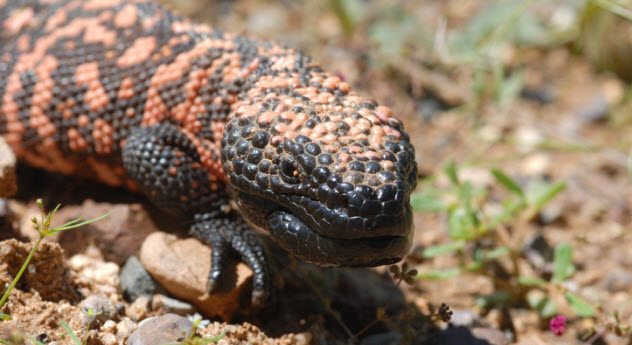
Despite the impressive title of the only venomous lizard in the United States, the Gila monster is not deadly to humans. A bite will cause severe pain and bleeding and getting the animal to let go can be difficult, but the Gila (pronounced “Hee-lah”) monster’s venomous saliva is actually more helpful to humans than it is harmful.
One component of the venom, exendin-4, has become the foundation for a whole new class of medications designed to treat type 2 diabetes. Naturally, we might ask why lizard spit helps those suffering from insulin resistance? After all, the two seem more than a little removed from each other.
The answer, though, lies in the uniqueness of the Gila monster’s metabolism and survival mechanisms. In the wild, this particular lizard only eats 5–10 times a year.
Exendin-4 is also very similar to a human protein, GLP-1, which helps the body regulate how much insulin it produces. The drug created from this protein, Byetta, helps type 2 diabetics maintain healthy glucose levels.[3] It can also lead to weight loss and a decrease in appetite. Byetta is FDA approved and prescribed as a self-administered injection.
7 Waxy Monkey Frog

The waxy monkey frog secretes a number of proteins through its skin, including the waxy oil that has given the frog its name and allows it to reduce the amount of water lost through its skin. The frog also secretes a hallucinogenic poison which causes tachycardia, vomiting, and hyper-attuned senses.[4]
The composition of the poison is complex. But one of the identified proteins, dermorphin, is 40 times more potent than morphine as well as significantly less addictive.
In addition to their analgesic properties, these proteins actually have the ability to limit blood vessel growth. Although that might not sound like a good thing, it turns out that it is a very good thing in cancer research.
After reaching a certain size, most cancerous tumors need blood vessels to get necessary nutrients and oxygen. So controlling the growth and size of the blood vessels supplying tumors could actually allow doctors to starve them to death.
6 Chilean Rose Tarantula
 Muscular dystrophy is a genetic disease with no known cure. Every administered treatment is about managing the symptoms of the disease, which causes the body’s muscles to deteriorate until the patient is unable to move and becomes confined to a wheelchair. It’s a horrible disease that is diagnosed in childhood, dramatically reducing the expected life span of the patient.
Muscular dystrophy is a genetic disease with no known cure. Every administered treatment is about managing the symptoms of the disease, which causes the body’s muscles to deteriorate until the patient is unable to move and becomes confined to a wheelchair. It’s a horrible disease that is diagnosed in childhood, dramatically reducing the expected life span of the patient.
But thanks to the pet tarantula of a group of researchers, a more effective treatment might not be far off. Rosie is the name of the Chilean rose tarantula that the researchers kept as their mascot, which ultimately led them to their amazing discovery.
Grammostola spatulata’s venom contains a protein called GsMTx4. Through their research, the group found that this protein can stop the body from destroying its own muscle mass by cutting off certain pathways to the affected cells.[5]
In fact, a study done on dystrophic mice found that, when treated with the protein, the mice’s strength actually increased. In addition, the protein was found to have absolutely no toxicity in mice.
This treatment is somewhat revolutionary because it is not a genetic therapy. It treats the symptoms of the disease, not the cause. So while it is not a cure, it can increase quality of life in patients and help combat the symptoms they experience.
5 Deathstalker
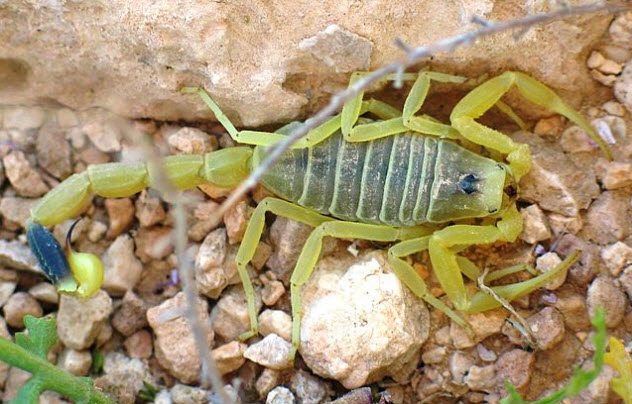
Under UV light, all scorpions glow in the dark. One particular scorpion, however, is shedding light on a completely different area: cancer treatment.
Commonly known as the deathstalker scorpion, Leiurus quinquestriatus is being studied for the chlorotoxin found in its venom. This toxin is unique because it attaches itself only to cancerous cells, leaving healthy ones alone.
But why is this important?
As chlorotoxin only binds to cancerous cells, it can be used to make tumors more visible. Similar to how the scorpion itself glows under UV light, “tumor dye” can be attached to the chlorotoxin and used to illuminate the cancerous cells.[6]
This makes tumors much easier to see for surgeons, who essentially “go in blind” when operating. Since infrared light is invisible to the human eye, surgeons still have to use a screen to see the highlighted tumors. But this method works better than the 2-D printed MRI image that is most commonly used.
The “tumor paint” method has been used successfully in a handful of surgeries already and is slated for more tests and trials. Given a few years, we all might be able to shine bright like a scorpion.
4 Puffer Fish
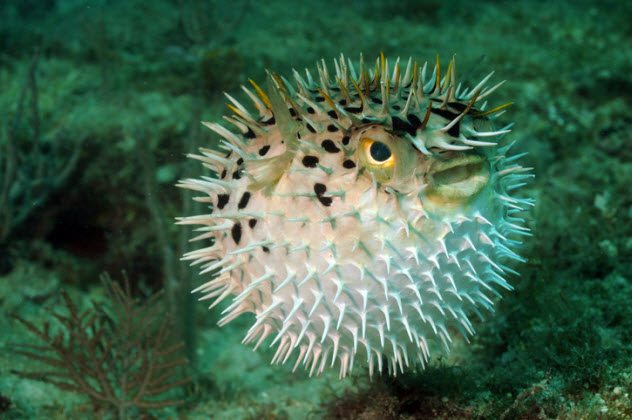 Pain is a problem. In 2016, US citizens paid almost $380 billion for prescription painkillers. Many of them are opioids, medications to which we can get addicted very fast.
Pain is a problem. In 2016, US citizens paid almost $380 billion for prescription painkillers. Many of them are opioids, medications to which we can get addicted very fast.
For people with chronic pain, like those suffering from arthritis or cancer, opioids can be helpful. But they can also require patients to deal with a new set of problems from addiction.
Cancer pain is particularly hard to manage because the cause cannot always be treated. If someone has a tension headache, they can usually release the tension via massage or other relaxation techniques. But cancer pain is usually caused by a tumor pressing against sensitive nerves. If it is not removed, the tumor continues to press, making the pain chronic.
So how does the puffer fish fit into this?
Puffer fish (Tetraodontidae) are a highly regulated delicacy in Japan. The reason is that puffer fish contain a deadly neurotoxin called tetrodotoxin (TTX) that is responsible for a handful of deaths every year. TTX is a paralytic, meaning that it attacks nerve tissue and eventually renders the victim paralyzed.
Nerve tissue is responsible for how we feel pain, and studies show that low doses of TTX can block those pain signals from the nerve tissue without damaging it.[7] In addition, TTX is nonaddictive. So those suffering from chronic pain can take it without worrying about relying on it for the rest of their lives.
Under the name Tectin, TTX is currently in Phase 3 trials, the final step before the drug can be submitted for FDA approval.
3 Brazilian Pit Viper

Our slithery friend is not on this list because it has the potential to save lives. The Brazilian pit viper has been there and done that already. However, unlike most creatures on this list, its medical purposes do not have much to do with pain.
ACE inhibitors are used to treat hypertension, which is abnormally high blood pressure. Hypertension can damage the heart and the arteries and eventually lead to death. Before the discovery of ACE inhibitors, the treatments for hypertension were a little unusual, including injecting the patient with something to cause a fever, which indirectly reduces blood pressure.
It turns out that Brazilian pit vipers kill their prey with a specific compound in their venom. This compound makes the prey’s blood pressure drop quickly to an extremely low level, causing the prey to black out. The compound is an ACE inhibitor. In small enough doses, it increases the diameter of the blood vessels, reducing blood pressure.[8]
The Brazilian pit viper’s venom and the discoveries surrounding it allowed commercial drugs such as captopril to be produced and prescribed to patients suffering from hypertension.
2 Cone Snail
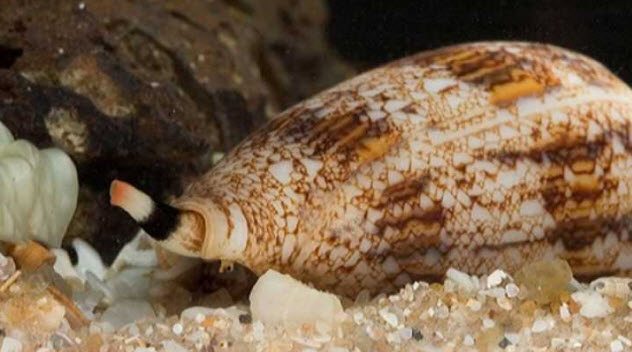
Our third marine member has a bite that is definitely worse than its bark. The cone snail has a hypodermic-like stinger used to inject venom into its prey, which ranges from tiny marine worms to bottom-feeding fish. The venom paralyzes the prey, allowing the snail to eat its fill.
The venom of the bigger snails is so potent that it can be deadly to humans.[9] But scientists have isolated a single pain-killing protein from the cone snail’s venom called ziconotide, which happens to be 1,000 times as powerful as morphine. A drug made from this synthesized protein is actually on the market right now under the name Prialt.
1 Brazilian Wandering Spider
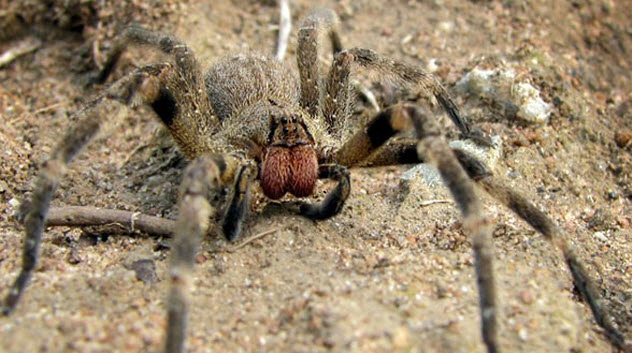
We’ve all heard the commercials: Please consult a doctor if your erection lasts more than four hours. This time, though, the warning is attached to a spider, not a bottle of pills.
The Brazilian wandering spider boasts a leg span of up to 13 centimeters (5 in). When agitated, it can rear back on its hind legs like it is looking for a fight. But perhaps the scariest part about this spider is a side effect of its bite: In males, the spider’s venom can trigger a four-hour erection that can ultimately lead to death.
Because of this strange side effect, scientists are studying the spider’s venom to help treat erectile dysfunction, especially in those who are resistant to Viagra.[10] So while the spider is not helping to save lives, it could be helping to better them very soon.
Marisa is a college student majoring in mathematics with a passion for the written word.
Read more amazing stories of other terrifying creatures on 10 Terrifying Creatures Of The Amazon River and 10 Spineless Creatures That Could Decimate You.








